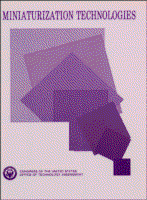No edit summary |
(Adding categories) Tag: categoryselect |
||
| (One intermediate revision by the same user not shown) | |||
| Line 10: | Line 10: | ||
This report analyzes various technologies that may be important for future advances in [[miniaturization]]. Current research in the United States and other nations is pushing the limits of [[miniaturization]] to the point that structures only hundreds of atoms thick will be commonly manufactured. Researchers studying atomic and molecular interactions are continuing to push the frontiers, creating [[knowledge]] needed to continue progress in [[miniaturization]]. Scientists and engineers are creating microscopic mechanical structures and biological [[sensor]]s that will have novel and diverse applications. |
This report analyzes various technologies that may be important for future advances in [[miniaturization]]. Current research in the United States and other nations is pushing the limits of [[miniaturization]] to the point that structures only hundreds of atoms thick will be commonly manufactured. Researchers studying atomic and molecular interactions are continuing to push the frontiers, creating [[knowledge]] needed to continue progress in [[miniaturization]]. Scientists and engineers are creating microscopic mechanical structures and biological [[sensor]]s that will have novel and diverse applications. |
||
| + | [[Category:Publication]] |
||
| + | [[Category:Technology]] |
||
| + | [[Category:1991]] |
||
Latest revision as of 22:03, 14 September 2015
Citation[]

Office of Technology Assessment, Miniaturization Technologies (OTA-TCT-514) (Nov. 1991) (full-text).
Overview[]
Advances in miniaturization technologies have had dramatic impacts on our lives. Radios, computers, and telephones that once occupied large volumes now fit in the palm of a hand. Dozens of sensors are sent on spacecraft to the planets and on instruments into the human body. Electronic brains are in everything from bombs to washing machines.
This report analyzes various technologies that may be important for future advances in miniaturization. Current research in the United States and other nations is pushing the limits of miniaturization to the point that structures only hundreds of atoms thick will be commonly manufactured. Researchers studying atomic and molecular interactions are continuing to push the frontiers, creating knowledge needed to continue progress in miniaturization. Scientists and engineers are creating microscopic mechanical structures and biological sensors that will have novel and diverse applications.